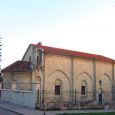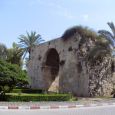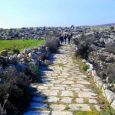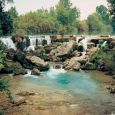Tarsus
Advertisement
By Train
Fairly modern and very frequent trains from Adana and Mersin.The trunk line bypasses the city about a few km to the east.Yenice is the nearest trunk line station and has daily connections to main centres of the country such as Istanbul and Ankara.
By Air
The nearest airport is in nearby Adana.
By Bus
From Mersin and Adana there are frequent dolmuses and buses.Tickets are less than 3 lira to and from both cities.
Cleopatra's Gate
is a city gate of Tarsus, in Mersin Province, Turkey, named after the Egyptian queen Cleopatra VII.Tarsus, located in the region known as Cilicia Pedias in Antiquity (modern south-central Turkey), was an important city during both the ancient and the medieval eras.It was the capital of Roman province of Cilicia.In 41 BC. Mark Antony during his struggle against Octavian allied himself with Cleopatra VII in Tarsus.Cleopatra entered Tarsus via the port gate.The history of the gate after Cleopatra is not documented but by analyzing the building stones and the cement it is usually believed that the original gate was rebuilt during the Middle Ages either by the Byzantine Empire or by the Abbasids.The popular name of the gate was Kancik Kapi (feminine gate) during the late Ottoman period.However from the early 20th century the name Cleopatra kapısı ("Cleopatra's Gate") replaced the former name.
Saint Paul's Church
is a church in Tarsus, Mersin Province, Turkey.Tarsus in Cilicia of the antiquity what is now South Turkey, was an important city during both ancient and medieval ages.The tombs of Daniel of the Bible and Al-Ma'mun (786-833), the caliph are in Tarsus.Saint Paul was a resident of Tarsus. He was born and lived in Tarsus as a Jew named Saul and after converting, made a number of missionary journeys during which he was arrested and beheaded by emperor Nero of Roman Empire in AD 64 or 67 on the 29th of June.After Saint Paul's death, Tarsus continued as an important city of the area.It became a part of the Byzantine Empire, the Abbasid Empire, the Seljuk Empire, the Armenian Kingdom of Cilicia, the Ramadanids and the Ottoman Empire.It is not known if there had been any churches established by Paul in Tarsus.But in 1704 P.Lucas wrote that there was Roman style church which had been built by Saint Paul. V.Langlois who visited Tarsus in 1851 confirmed this. In his words, thick walls which resemble Roman style, windows which are narrower in outer side than inside, and thick columns are noticeable.But no other records exist to back this claim.
Tarsus Grand Mosque
is a mosque in Tarsus, Mersin Province, Turkey.The mosque had been built in 1579 during Ottoman rule. The commissioner of the mosque is İbrahim Bey of Ramadanid dynasty, a Turkmen dynasty which was the ruler of the region before 1517 and continued as the vassal of the Ottoman Empire during the rest of the 16th century.But according to information plate of the mosque, there was an older mosque in the place of Grand Mosque which was built during the Abbasid (Arab) rule in the 9th century.After Tarsus was captured by the Byzantine Empire, the old mosque was transformed into a church.But in the 14th century Ramazanoglu captured Tarsus and in 1579 the mosque was rebuilt.The entrance to mosque courtyard is via a monumental marble gate at the north.The nartex with 14 columns to bear 16 domes has been decorarated with tiles.The building material of the main building is carved stone.The columns in the main building have been connected with half pointed arch so called Iranian Arch.The pulpit and the niche (directed to Mecca) is made of marble.
Karabucak Forest
is a forest plantation in Turkey.During the ancient ages, Tarsus was a Mediterranean Sea port. But because of alluvial deposits from the Berdan River the coastline was continuously moving to south. By the 6th century, the coastline had already been moved away and a small lagoon named Rhegma had been formed which obstructed the river flow in the rainy seasons and caused floods. Byzantine Emperor Justinian I (reigned 527-565) had a channel constructed at the east of the city to facilitate easier flow. (present watercourse of the river). After 7th century the lake was partially dried up and turned into marshes. But because of the marshes, the number of malaria cases increased sharply. In 1939, the Turkish government (ministry of forestry) started a project to drain the marshes. Eucalyptus trees were planted on 885 hectare area and the marshes were totally drained. In 1960s the forest was further enlarged by covering the coastal band. Pine was preferred in the coastal band.The marsh has been drained and the sands movement at the coast has been checked. The forest in addition to being a source of revenue, is now a popular picnic area for Tarsus citizens.
Eshab Cave
Kahf is the cave on Ashab ul claiming to be within the limits of the city's four of 33 Turkiye dedir: Afsin, Selcuk, Ephesus, Lice and Tarsus.Christians adopted by the release of the cave Selcuk district of Ephesus near the ancient town located at the foot of Mount Fair.This has been a church on top of the cave excavations unearthed in a state between the years 1927-1928, 5 and 6 as a result of excavation century were found in the tombs. Seven Uyurlara inscriptions and tombs as well as inside the church is dedicated.More than cave in Turkey, where the discussion about the Afsin and Tarsus is between the towns.The grotto of the Seven Sleepers Afsin district to prove that the Association Afsin Ashab-i-Kahf a delegation of scientists reported the discovery proceedings opened with the decision of the court of hazırlatmis and it baglatmistir.Tarsus, Tarsus, two hours away from the cave on the mountain called Encilus Bencilus or commentaries, historical sources Ashab-i-Kahf on the basis of archival documents and as a show cave.
Roman road in Cilicia
is a part of a Roman road in Mersin Province, Turkey.The road is thought to have been constructed in the 1st century AD by the Roman Empire.But according to a restoration inscription next to the road it was rebuilt or repaired during the reign of Caracalla in the 3rd century.The original gate, dated to 5th century, was destroyed at some point and the present gate was reconstructed much later.The road is stone pavement and there are stone parapets on each side of the road.The width of the road excluding the parapet is about 3 metres (9.8 ft).The outher dimensions of the cut stone gate is 8.8 m. wide x 5.2 m. high ( 28.98 ft high x 17 ft wide).The inner width is 4.11 metres (13.5 ft).
Information not available






